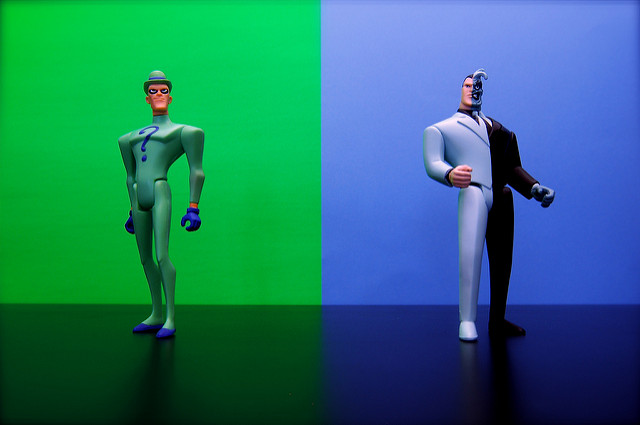Posts Tagged ‘Learning’
A Little Uninterrupted Work Goes a Long Way
 If your day doesn’t start with a list of things you want to get done, there’s little chance you’ll get them done. What if you spent thirty minutes to define what you want to get done and then spent an hour getting them done? In ninety minutes you’ll have made a significant dent in the most important work. It doesn’t sound like a big deal, but it’s bigger than big. Question: How often do you work for thirty minutes without interruptions?
If your day doesn’t start with a list of things you want to get done, there’s little chance you’ll get them done. What if you spent thirty minutes to define what you want to get done and then spent an hour getting them done? In ninety minutes you’ll have made a significant dent in the most important work. It doesn’t sound like a big deal, but it’s bigger than big. Question: How often do you work for thirty minutes without interruptions?
Switching costs are high, but we don’t behave that way. Once interrupted, what if it takes ten minutes to get back into the groove? What if it takes fifteen minutes? What if you’re interrupted every ten or fifteen minutes? Question: What if the minimum time block to do real thinking is thirty minutes of uninterrupted time?
Let’s assume for your average week you carve out sixty minutes of uninterrupted time each day to do meaningful work, then, doing as I propose – spending thirty minutes planning and sixty minutes doing something meaningful every day – increases your meaningful work by 50%. Not bad. And if for your average week you currently spend thirty contiguous minutes each day doing deep work, the proposed ninety-minute arrangement increases your meaningful work by 200%. A big deal. And if you only work for thirty minutes three out of five days, the ninety-minute arrangement increases your meaningful work by 400%. A night and day difference.
Question: How many times per week do you spend thirty minutes of uninterrupted time working on the most important things? How would things change if every day you spent thirty minutes planning and sixty minutes doing the most important work?
Great idea, but with today’s business culture there’s no way to block out ninety minutes of uninterrupted time. To that I say, before going to work, plan for thirty minutes at home. And set up a sixty-minute recurring meeting with yourself first thing every morning and do sixty minutes of uninterrupted work. And if you can’t sit at your desk without being interrupted, hold the sixty-minute meeting with yourself in a location where you won’t be interrupted. And, to make up for the thirty minutes you spent planning at home, leave thirty minutes early.
No way. Can’t do it. Won’t work.
It will work. Here’s why. Over the course of a month, you’ll have done at least 50% more real work than everyone else. And, because your work time is uninterrupted, the quality of your work will be better than everyone else’s. And, because you spend time planning, you will work on the most important things. More deep work, higher quality working conditions, and regular planning. You can’t beat that, even if it’s only sixty to ninety minutes per day.
The math works because in our normal working mode, we don’t spend much time working in an uninterrupted way. Do the math for yourself. Sum the number of minutes per week you spend working at least thirty minutes at time. And whatever the number, figure out a way to increase the minutes by 50%. A small number of minutes will make a big difference.
Image credit – NASA Goddard Space Flight Center
Innovation – Words vs. Actions
 Innovation isn’t a thing in itself. Companies need to meet their growth objectives and innovation is the word experts use to describe the practices and behaviors they think will maximize the likelihood of meeting those growth objectives. Innovation is a catchword phrase that has little to no meaning. Don’t ask about innovation, ask how to meet your business objectives. Don’t ask about best practices, ask how has your company been successful and how to build on that success. Don’t ask how the big companies have done it – you’re not them. And, the behaviors of the successful companies are the same behaviors of the unsuccessful companies. The business books suffer from selection bias. You can’t copy another company’s innovation approach. You’re not them. And your project is different and so is the context.
Innovation isn’t a thing in itself. Companies need to meet their growth objectives and innovation is the word experts use to describe the practices and behaviors they think will maximize the likelihood of meeting those growth objectives. Innovation is a catchword phrase that has little to no meaning. Don’t ask about innovation, ask how to meet your business objectives. Don’t ask about best practices, ask how has your company been successful and how to build on that success. Don’t ask how the big companies have done it – you’re not them. And, the behaviors of the successful companies are the same behaviors of the unsuccessful companies. The business books suffer from selection bias. You can’t copy another company’s innovation approach. You’re not them. And your project is different and so is the context.
With innovation, the biggest waste of emotional energy is quest for (and arguments around) best practices. Because innovation is done in domains of high ambiguity, there can be no best practices. Your project has no similarity with your previous projects or the tightest case studies in the literature. There may be good practice or emergent practice, but there can be no best practice. When there is no uncertainty and no ambiguity, a project can use best practices. But, that’s not innovation. If best practices are a strong tenant of your innovation program, run away.
The front end of the innovation process is all about choosing projects. If you want to be more innovative, choose to work on different projects. It’s that simple. But, make no mistake, the principle may be simple the practice is not. Though there’s no acid test for innovation, here are three rules to get you started. (And if you pass these three tests, you’re on your way.)
- If you’ve done it before, it’s not innovation.
- If you know how it will turn out, it’s not innovation.
- If it doesn’t scare the hell out of you, it’s not innovation.
Once a project is selected, the next cataclysmic waste of time is the construction of a detailed project plan. With a well-defined project, a well-defined project plan is a reasonable request. But, for an innovation project with a high degree of ambiguity, a well-defined project plan is impossible. If your innovation leader demands a detailed project plan, it’s usually because they are used running to well-defined continuous improvement projects. If for your innovation projects you’re asked for a detailed project plan, run away.
With innovation projects, you can define step 1. And step 2? It depends. If step 1 works, modify step 2 based on the learning and try step 2. And if step 1 doesn’t work, reformulate step 1 and try again. Repeat this process until the project is complete. One step at a time until you’re done.
Innovation projects are unpredictable. If your innovation projects require hard completion dates, run away.
Innovation projects are all about learning and they are best defined and managed using Learning Objectives (LOs). Instead of step 1 and step 2, think LO1 and LO2. Though there’s little written about LOs, there’s not much to them. Here’s the taxonomy of a LO: We want to learn if [enter what you want to learn]. Innovation projects are nothing more than a series of interconnected LOs. LO2 may require the completion of LO1 or L1 and LO2 could be done in parallel, but that’s your call. Your project plan can be nothing more than a precedence diagram of the Learning Objectives. There’s no need for a detailed Gantt chart. If you’re asked for a detailed Gantt chart, you guessed it – run away.
The Learning Objective defines what you learn, how you want to learn, who will do the learning and when they want to do it. The best way to track LOs is with an Excel spreadsheet with one tab for each LO. For each LO tab, there’s a table that defines the actions, who will do them, what they’ll measure and when they plan to get the actions done. Since the tasks are tightly defined, it’s possible to define reasonable dates. But, since there can be a precedence to the LOs (LO2 depends on the successful completion of LO1), LO2 can be thought of a sequence of events that start when LO1 is completed. In that way, an innovation project can be defined with a single LO spreadsheet that defines the LOs, the tasks to achieve the LOs, who will do the tasks, how success will be determined and when the work will be done. If you want to learn how to do innovation, learn how to use Learning Objectives.
There are more element of innovation to discuss, for example how to define customer segments, how to identify the most important problems, how to create creative solutions, how to estimate financial value of a project and how to go to market. But, those are for another post.
Until then, why not choose a project that scares you, define a small set of Learning Objectives and get going?
Image credit – JD Hancock
Maximize The Learning Ratio
 As creatures of habit, we like to do what we did last time. Outcomes match expectations and things go as planned – no surprises, no delays, no problems. But as creatures swimming in an evolutionary soup, doing what we did last time leads to extinction. Customers’ expectations multiply and competitors mutate into a higher performing organism and eat us. There are two competing functions – do what we did last time to minimize energy and try new things to harden ourselves for the ever more competitive future.
As creatures of habit, we like to do what we did last time. Outcomes match expectations and things go as planned – no surprises, no delays, no problems. But as creatures swimming in an evolutionary soup, doing what we did last time leads to extinction. Customers’ expectations multiply and competitors mutate into a higher performing organism and eat us. There are two competing functions – do what we did last time to minimize energy and try new things to harden ourselves for the ever more competitive future.
You can’t reinvent yourself at every turn or your brain will run out of glucose and you’ll pass out. And you can’t always lounge on the couch or you’ll get out of shape and become a slow-moving snack for the new T-Rex on the block. If the endpoints lead to our demise, the solution must be something like the middle way.
If you can get away with it, do what you did last time – minimum energy living is a good gig if you can get it. With little investment and lots of return, there’s enough for everyone. Plenty to eat and some left over to put in stores for the winter. But plenty to eat and plenty of time to goof off may make for lazy (but happy) tribe members who may be of little use when it’s time to defend the business model against hostile species.
Live frugally to develop a surplus and spend some of it trying new things. Improved fitness is the best way to navigate the landscape, even the landscape still beyond the horizon. More than physical fitness, improved mental fitness is the dominant trait that leads to survival. But doing new work is energy intensive and must be done skillfully.
The primary reason we try new things is to learn. In that way, the new things we try are a means to an end – improved mental fitness. But because doing new is expensive from an energy perspective, the learning ratio (new learning divided by the energy to learn) must be high. First, be clear about what you want to learn because learning the wrong thing costs more energy than resting on the couch. Second, maximize the learning of your experiments.
If you run an experiment where you are 100% sure of the outcome, your learning is zero. You already knew how it would go, so there was no need to run the experiment. The least costly experiment is the one you didn’t have to run, so don’t run experiments when you know how they’ll turn out. If you run an experiment where you are 0% sure of the outcome, your learning is zero. These experiments are like buying a lottery ticket – you learn the number you chose didn’t win, but you learned nothing about how to choose next week’s number. You’re down a dollar, but no smarter.
The learning ratio is maximized when energy is minimized (the simplest experiment is run) and probability the experimental results match your hypothesis (expectation) is 50%. In that way, half of the experiments confirm your hypothesis and the other half tell you why your hypothesis was off track.
We can argue about the energy balance between leveraging best practices and creating new recipes. But, when you want to learn, there can be no argument – maximize the learning ratio.
Image credit – Craig Sunter
 Mike Shipulski
Mike Shipulski